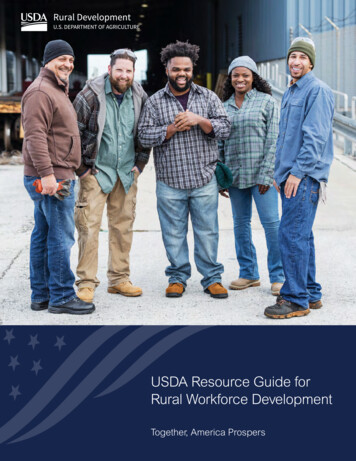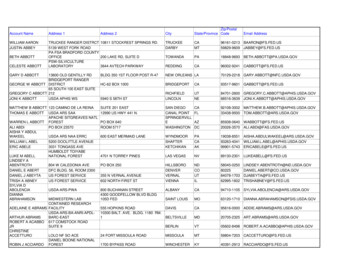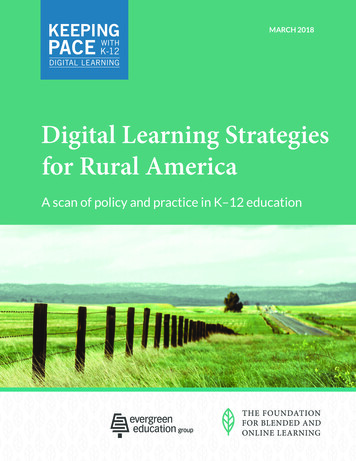
Transcription
USDA Resource Guide forRural Workforce DevelopmentTogether, America Prospers
ContentsHow Your Rural Community can useUSDA Programs to Build a Stronger Workforce. . . . . . . . . . . . . . . . . . . . . . . . . . 2Workforce Development Planning. . . . . . . . . . . . . . . . . . . . . . . . . . . . . . . . . . . . . . . . . . . . 2Infrastructure and Equipment Financing . . . . . . . . . . . . . . . . . . . . . . . . . . . . . . . . . . . . . . . 4Industry and Employer Engagement,Entrepreneurship and Local Business Development. . . . . . . . . . . . . . . . . . . . . . . . . . . . . . 6Education, Training and Apprenticeship. . . . . . . . . . . . . . . . . . . . . . . . . . . . . . . . . . . . . . . 8Rural Workforce Resource Guide Matrix. . . . . . . . . . . . . . . . . . . . . . . . . . . . . . . 10Other Federal Agency Programs . . . . . . . . . . . . . . . . . . . . . . . . . . . . . . . . . . . . 16Additional Resources Available at USDA. . . . . . . . . . . . . . . . . . . . . . . . . . . . . . 17USDA Contact Information . . . . . . . . . . . . . . . . . . . . . . . . . . . . . . . . . . . . . . . . . 17
Created by the USDA Rural Development Innovation CenterAmerica’s rural workforce provides a vital foundation for the nation’s economy . Rural Americasupplies the nation’s food and energy resources, and the fiber necessary for goods andmanufacturing . As USDA continues to respond to the COVID-19 pandemic and help restorethe economy, we remain committed to supporting rural employers and job seekers to rebuildrural America’s workforce better, stronger and more equitably than ever before .For these reasons, USDA is prioritizing collaborations with its federal partners to help startand grow thousands of businesses and give individuals the educational and financial toolsto succeed in rural America . This guide was created for community leaders and other localentities to help them access resources to create jobs, train talent, expand educationalopportunities and provide technical assistance . The guide outlines programs and servicesavailable at USDA and other federal departments and agencies that support workforcedevelopment in rural communities .The guide highlights four key assistance types necessary to building a stronger rural workforce:1.Workforce development planning2.Infrastructure and equipment financing3.Industry and employer engagement, entrepreneurship and local business development4.Education, training and apprenticeshipExamples on page 2 illustrate how customers have used USDA programs to support eachassistance type. A resource matrix on page 10 organizes USDA funding opportunities bycustomer and assistance type.A list of additional federal resources that complement USDA funding opportunities isprovided on page 16. Additional USDA resource guides are available on page 17.
How Your Rural Communitycan use USDA Programs toBuild a Stronger Workforce1. Workforce Development PlanningRecommended PracticesIdeally, workforce development planning is supported byvarious organizations in your community, such as yourChamber of Commerce, local workforce developmentboard, and government leaders. Good planning ensurescommunities and businesses are equipped with skills,experiences and competencies that meet the presentand future needs of a given workforce. A network ofstakeholders – including state and local government,education and training institutions, employers,entrepreneurs, and social and infrastructure serviceproviders – must be at the table in order to build acomprehensive plan. Invite your local workforce development board toparticipate and monitor priorities in your region to leverageits funding resources for your community. Contact yourstate government agency to find your local board. Use key data – such as employment rates anddemand for services in your rural area – tounderstand workforce gaps and opportunities, makestrategic investments, identify and nurture strategicpartnerships, and track impact. Identify and understand the unique characteristics,opportunities and workforce development needs ofvarious population groups (for example: youth, adults,rural communities, or veterans). Integrate the needs of employers and workers. Align workforce development planning and economicdevelopment planning activities at an early stagein the plan. Develop cross-sector strategies and governance. Periodically revise your plan.2
Success Storyand economic development projects in rural areas. Thefunds can be used to develop strategic plans, accessalternative funding sources, support board training,organize fundraisers, develop childcare facilities andcreate training tools.Regional Plan Sets Solid Foundationfor Workforce Development inRural Tennessee(Rural Community DevelopmentInitiative Grants)TBR used the grant to increase technical careerawareness among K-12 students and improve dualenrollment opportunities for high school students to earncollege credit and technical career certifications at theTennessee Colleges of Applied Technology. The grantfinanced a regional digital portal to help students, staffand parents access resources, toolkits and courses.Funding also helped implement more effective uses ofregional labor market data to better align individuals withcareers that will have the greatest economic impact.The Tennessee Board of Regents (TBR) partnered withthe National Rural Education Association (NREA) todevelop a regional approach to workforce developmentplanning for four rural counties in Tennessee.In 2019, Chester, Decatur, Henderson and Perrycounties each were designated as economicallydistressed, at-risk, or transitional. To help spur long-termgrowth in community and economic development, thetwo organizations devised a plan to leverage communityfunding, resources and subject matter experts to helpimprove workforce readiness.TBR campuses are actively working with county,business and industry leaders to prepare students forlife beyond high school. Funding also supports collegecurriculum and career plan development for students tohelp meet the region’s workforce needs.USDA Rural Development awarded TBR a 250,000Rural Community Development Initiative (RCDI) grantto support this project. The RCDI program helpscommunity development organizations, low-incomerural communities and federally-recognized Tribesfinance housing, community facilities and communityThis project is an example of USDA’s commitment tosupport new and creative ways to collaborate with localorganizations to spur community development, growbusinesses, and give individuals the financial tools tosucceed in rural America.The College System of Tennessee, governed by theTennessee Board of Regents (TBR), is Tennessee’s largesthigher education system, governing 40 post-secondaryeducational institutions with over 200 teaching locations. TheTBR system includes 13 community colleges, 27 colleges ofapplied technology, and TN eCampus, providing programsto students across the state, country, and world.3
2. Infrastructure andEquipment FinancingRecommended Practices Identify gaps and opportunities to make strategicinfrastructure investments supporting workforcedevelopment goals.Infrastructure and social services are driving factors inattracting and retaining industries and employees. Highspeed internet, transportation facilities, and water andwaste facilities all are critical for industry growth. Accessto health care, education, nutrition and communityspaces help improve quality of life. Design social service programs that meetdemographic needs (for example: veterans, singleparents, age or disability status). Invest in infrastructure that enables access totechnology and expands training and employmentopportunities for communities with physicaltransportation barriers.Broadband connectivity is a vital infrastructure obstaclefor rural economic development right now.4
Success Storydirector of the Candler County Industrial Authority.“Broadband connectivity is a vital infrastructure obstaclefor rural economic development right now, but it is thestrongest advantage we have in Metter.Rural Telephone CooperativeTakes Networking to New Level(Telecommunication DirectLoan Program)For that, I am thankful, and happy to partner withPineland Telephone Cooperative to be able tohelp companies flourish financially in this amazingsmall town.”Built on speculation and hope, a 42,000-square-footfacility in rural Metter, Georgia stood empty for nearly30 years, awaiting the perfect occupant. In fact, it wasthe oldest “spec” building in the state until 2014, whenAustralian entrepreneur Sebastian Falzon spotted itas a diamond-in-the-rough. Within a year, Falzon – thepresident of Australia-based Concrete Pump Engineering(CPE) – moved its North American headquarters to Metter.Pineland Co-op General Manager Dustin Durdencautions that the mere presence of broadband doesn’tnecessarily mean businesses will come. But, whilefoundational infrastructure such as electricity, water, andwastewater treatment may be considered prerequisitesfor telecommunications, Durden says in modern times,“Not having broadband is an eliminating factor.”Globally partnered with Korea-based Everdigm – aninternational leader in concrete pumps, hydraulicattachments, and tower cranes – CPE America is theNorth American distributor of Everdigm concrete pumpsused in commercial, housing, and industrial construction.Why would a multinational, multimillion dollar companychoose to land in such a small American town? As the oldreal estate mantra goes, “Location, location, location!”In a small town where public-private cooperation is keyto sustaining a strong local economy, Pineland Co-op isdoing its part to ensure its communities have access toleading-edge broadband connectivity. A USDA partnersince the 1950s, Pineland has steadily developed itsnetwork capacity, offering increasingly diverse servicesand now, fiber technology. In the last 10 years, Pinelandhas received two awards totaling more than 28 millionfrom USDA’s Rural Utilities Service. With these funds,Pineland constructed more than 1,800 miles of fiber andprovided expanded video and gigabit-enabled packagesto co-op members.Flanking Interstate 16, Metter offers easy access tothe Port of Savannah. It’s known as a family-friendlytown with a robust education system. But perhapsmost importantly – thanks to Metter-based PinelandTelephone Cooperative’s longstanding initiatives in theregion – access to reliable broadband infrastructuremoved the Candler County town of 4,000 to the top ofCPE America’s list.Both Mullins and Durden emphasize the importance offostering collaborative energy across businesses, publicinstitutions, and the workforce. In another testament tothe power of partnerships, Pineland worked closely withthe Candler County Industrial Authority to ease CPEAmerica’s move to Metter, ensuring the fiber connectionto the former spec building was robust and ready.Following six years of consistent growth, CPE Americacontinues to thrive. While CPE’s Southeast Georgialocation certainly contributes to its success, the companycould not have endured – particularly during theCOVID-19 pandemic – without strong global connectivity.In Metter, neither CPE America – nor any other company– has to worry about having reliable broadband internetservice to continue efficient, effective operations. With100 percent broadband coverage in the entire CandlerCounty area, businesses, employees, and their familieshad one less obstacle to overcome during the pandemic.Pineland’s collaborations also extend beyond theIndustrial Authority and the Metter-Candler Chamberof Commerce to encompass rural communities andorganizations who want to provide broadband to theircustomers outside the Pineland service area.USDA is pleased to continue its 70-year partnershipwith Pineland Telephone Co-op and hundreds ofother organizations dedicated to bringing fast, reliablebroadband access – as important today as electrificationwas in the 1930s – to rural America.“Thanks to Pineland Telephone and their forward-thinkinginitiatives, Metter companies, schools, and families do nothave to worry about staying connected to live their livesto their fullest potential,” said Hannah Mullins, executive5
3. Industry and EmployerEngagement, Entrepreneurshipand Local Business DevelopmentRecommended Practices Invest in resources to spark innovation,entrepreneurship and business development intargeted sectors.Active employer engagement is critical to developingeffective education and training programs that meetcurrent and anticipated workforce demands. Prior todesign and delivery, industry partners should be given theopportunity to not only to share their workforce needs, butalso to contribute continually to the design and delivery oftraining curricula and apprenticeship programs. Engage employers from target sectors and identifytheir specific workforce needs. Build partnerships with community organizations –such as chambers of commerce or trade organizations– for an effective and coordinated collaboration withindustry partners. Consult industry partners to help design educationprograms and curricula. Engage employers to help develop work-basedlearning and apprenticeship programs. Partner with U.S. Department of Labor’s Job Corps tohelp industry partners recruit and train youth.Self-sufficiency, wise resource management, and a spirit ofentrepreneurship have always been traditional Lakota values.Four Bands helps our people and communities grow thesevalues and adapt them to today’s modern economy.6
Success StoryCheyenne River Sioux ReservationInvestments Target Cycle of PovertyProgramDollar Amount Date Closed or ObligatedActive Grant ProgramBusiness Incubator, CommunityFund Cultivates Tribal EconomicOpportunity, ProsperityRural Business Development GrantRBDG 99,9992020RBDG 99,9992018RBDG 99,9982017RBDG 87,7002016RBDG 99,9952015RBEG 99,0002013RBEG 99,0002012RBEG 99,0002011RBEG 55,0002010RBEG 75,0002008RBEG 74,0002007RBEG 65,0002006RBEG 55,0002005RBEG 60,0002004RBEG 50,0002002RBEG 50,0002011RBOG 50,0002013RBOG 50,0002012RBOG 50,0002011RBOG 50,0002009RBOG 95,0002007RBOG 95,0002006RBOG 75,0002005RBOG 95,0002004RBOG 50,0002002RBOG 50,0002001Absorbed into RBDGA little more than two decades ago, the nonprofitFour Bands Community Fund launched an innovativecommunity and economic development movement onthe Cheyenne River Sioux Reservation.Four Bands leverages partnerships with USDARural Development, the Bureau of Indian Affairs,the Indian Health Service, The Federal DepositInsurance Corporation (FDIC), the U.S. Departmentof the Treasury’s Community Development FinancialInstitutions (CDFI) Fund, and local businesses, lenders,and partners to maximize community impact. FourBands creatively meets the community’s capital andtechnical assistance needs and develops business andhousing opportunities on the Cheyenne River SiouxReservation and for its enrolled Tribal members living inSouth Dakota.Absorbed into RBDGSince 2001, USDA Rural Development’s commitmentto the Fund has led to 26 distinct awards from the RuralBusiness Development Grant (RBDG) program andits predecessors – the Rural Business Enterprise, andRural Business Opportunity Grant programs.In addition to the revolving loan fund, Four Bandsuses Rural Development-funded resources to providetechnical assistance and training through its Eagle Buttebusiness incubator, advising entrepreneurs on how tofinance and manage their rural businesses.Four Bands helps establish and support small andemerging businesses in a reservation area whichhistorically has struggled with high poverty andunemployment. This locally-grown solution offers hope– and creates opportunity – for rural Native Americanfamilies and the communities in which they live. Thelong-term positive impacts of this investment in thespirit of entrepreneurship are inspiring, and USDA RuralDevelopment is honored to be a part of such a vital,ongoing collaboration.To learn more about Four Bands, visitfourbands.org/programs/.7
4. Education, Trainingand ApprenticeshipRecommended Practices Invite your local workforce development board toparticipate and monitor workforce developmentpriorities in your region and access funding resources.Competency-based education is a personalizedapproach that aims to identify, acquire and trackprogress of foundational, technical, sectoral, industrybased and occupational skill sets and competenciesessential to growing a globally competitive and agileworkforce. Educational institutions are increasinglyturning toward competency-based education becauseit is an effective learning mechanism that measuressuccess through knowledge mastery instead oftime spent learning. This type of education can startto be delivered in K-12 or at technical and highereducation institutions. It can also be incorporated intoapprenticeship programs. Use data strategically to understand workforce gaps andopportunities and make strategic investments, identifyand nurture strategic partnerships and track impact. Understand the unique characteristics, opportunitiesand workforce development needs in variouspopulation groups (e.g. youth, adults, ruralcommunities, veterans, etc.) Integrate the needs of employers and workers. Align workforce development planning and economicdevelopment planning activities at an early stage inthe plan. Develop cross-sector strategies and governance. Revise plan periodically.8
Success StoryFor example, five new telepresence robots now facilitatecollaborative learning environments and professionaldevelopment services throughout ESC’s network ofschool districts. For students that are homebound, oftendue to a long-term illness, these robots help maintaineducational continuity by allowing them to attend schoolremotely. From home, these students use a tablet tocontrol the robot, which wheels from class to class,transmits live instruction, and interacts with teachersand peers.Grant Provides Rural Schoolswith Robots (and College Credits)Distance Learning Telemedicine ProgramOhio’s educators are keying into innovative solutionswhen it comes to serving their rural students. In placeslike Plymouth, Ohio, whose population is under 2,000,students often are unable to access certain classes,particularly those that qualify for the state’s free CollegeCredit Plus (CCP) education program. This programgives eligible students the unique opportunity tograduate with a high school diploma in one hand andcollege credits, possibly even an associate degree orcollege certificate, in the other hand. To participate inthis program, students may attend classes at a collegecampus, at school with credentialed instructors, oronline. However, for rural students even this degree offlexibility can be limiting. Dual enrollment courses are notoffered in many rural schools. To address this gap, NorthCentral State College (North Central) is using distancelearning to increase the capacity of rural schoolsthroughout north central Ohio.“We are happy to look at opportunities to get these [robots]out into the schools so they can be used for learning,”ESC Director of Education Amanda Mahon said.By working together to distribute and utilize resourcesin creative ways, these multilevel partnerships increasestudent exposure to specialized content in high needsubject areas like STEM and enhance professionaldevelopment opportunities for teachers throughoutthe region.With funding from a 2015 Rural Utilities Service DistanceLearning and Telemedicine grant, North Central nowconnects rural students, including those attendingPlymouth High School, to CCP courses–from generalclasses to specialized science, technology, engineering,and math (STEM) education. STEM education,in particular, is critical to development of a skilledworkforce, especially in a state where manufacturing isits largest sector, based on GDP. North Central installedvideo conferencing equipment in its learning andoutreach centers to deliver live college-level instructionto four rural schools as well as 15 school districts, whichare part of the Mid-Ohio Educational Service Center(ESC). In addition to increasing the number of advancedcourses available to students, North Central and ESCare using the grant funded equipment to increase schoolaccess in traditional and non-traditional ways.9
Rural Workforce Resource Guide MatrixCustomers*For-profitbusinesses orindividuals:Corporations,limited liabilitycompanies, ngInfrastructureand EquipmentUtilities, transportation,workforce housing, trainingcenters, end-use equipmentIndustry and EmployerEngagement,Entrepreneurship, LocalBusiness DevelopmentEmployer-basedcurriculum design,business site consultingEducation, Training,ApprenticeshipHigher education,skills-based training,vocational training,on-the-job trainingU.S. Forest Service US Forest ServiceYouth WorkforceDevelopment ProgramsRural Development Rural CommunityDevelopmentInitiative GrantsRural Development Rural EconomicDevelopment Loan andGrant ProgramRural Development Rural CommunityDevelopment InitiativeGrants Value-AddedProducer Grants Business and IndustryLoan Guarantees Value-AddedProducer Grants Rural EconomicDevelopmentLoan and GrantProgram Housing Preservation& RevitalizationDemonstration Loans &Grants Rural EconomicDevelopment Loanand Grant ProgramU.S. Forest Service US Forest ServiceYouth WorkforceDevelopmentPrograms Farm Labor Direct Loans& Grants Multifamily Housing DirectLoans and MultifamilyHousing Loan Guarantees Community Connect Grants Distance Learning andTelemedicine Grants Rural Broadband AccessLoan and Loan GuaranteeFarm Service Agency FSA Youth Loans Businessand IndustryLoan GuaranteesNational Institute of Foodand Agriculture AFRI Educationand WorkforceDevelopment Program Rural BusinessInvestment Program Veterinary Services GrantProgram (VSGP)National Institute ofFood and Agriculture Small BusinessInnovation Research Women and Minoritiesin Science, Technology,Engineering andMathematics FieldsGrant Program (WAMS) TelecommunicationsInfrastructure Loansand Guarantees Distributed GenerationEnergy Project FinancingFarm Service Agency FSA Beginning Farmersand Ranchers LoansFSA MicroloansNational Institute ofFood and Agriculture Small BusinessInnovation Research*Specific requirements apply. Please refer to the regulatory guidelines to learn more about applying for these opportunities.10
Rural Workforce Resource Guide MatrixCustomers*Public Entities:State or localgovernments,or federallyrecognizedTribes, or ral Development Rural BusinessDevelopmentGrants Rural CommunityDevelopmentInitiative Grants Rural EconomicDevelopmentLoan and GrantProgram CommunityFacilities TechnicalAssistance andTraining GrantInfrastructureand EquipmentUtilities, transportation,workforce housing, trainingcenters, end-use equipmentIndustry and EmployerEngagement,Entrepreneurship, LocalBusiness DevelopmentEmployer-basedcurriculum design,business site consultingEducation, Training,ApprenticeshipHigher education,skills-based training,vocational training,on-the-job trainingRural Development Rural BusinessDevelopment GrantsRural Development Rural BusinessDevelopment GrantsRural Development Rural BusinessDevelopment Grants Rural EconomicDevelopment Loan andGrant Program Rural CommunityDevelopment InitiativeGrants Community FacilitiesTechnical Assistance andTraining Grant Business and IndustryLoan Guarantees Rural EconomicDevelopment Loanand Grant Program Water and EnvironmentalPrograms SustainableManagement Tools Businessand IndustryLoan Guarantees Water and EnvironmentalPrograms Solid WasteManagement Grants Community FacilitiesTechnical Assistanceand Training Grant Intermediary RelendingProgram Community Facilities DirectLoans & Grants Community FacilitiesGuaranteed Loan Program Community FacilitiesRelending Program Water andEnvironmentalProgramsSustainableManagement Tools Economic ImpactInitiative Grants IntermediaryRelendingProgram (IRP) Farm Labor Direct Loans& Grants Community FacilitiesTechnical Assistance andTraining Grant Housing Preservation& RevitalizationDemonstration Loans &Grants Multifamily Housing DirectLoans and MultifamilyHousing Loan Guarantees Rural Housing SiteLoans Program11 IntermediaryRelending Program RuralMicroentrepreneurAssistance Program(RMAP)Farm Service Agency FSA Native AmericanFarm LoansOffice of Partnershipsand PublicEngagement SociallyDisadvantagedFarmers & Ranchers& Veteran Farmers &Ranchers Program Rural MicroentrepreneurAssistance Program(RMAP)National Institute of Foodand Agriculture AFRI Educationand WorkforceDevelopment ProgramFood and Nutrition Service Supplemental NutritionAssistance ProgramEmployment & Training(SNAP E&T)
Rural Workforce Resource Guide MatrixCustomers*(Continued)Public Entities:State or localgovernments,or federallyrecognizedTribes, or frastructureand EquipmentUtilities, transportation,workforce housing, trainingcenters, end-use equipmentRural Development Mutual Self-Help HousingTechnical Assistance Grants Community Connect Grants Distance Learning andTelemedicine Grants Rural Broadband AccessLoan and Loan GuaranteeIndustry and EmployerEngagement,Entrepreneurship, LocalBusiness DevelopmentEmployer-basedcurriculum design,business site consultingEducation, Training,ApprenticeshipHigher education,skills-based training,vocational training,on-the-job trainingOffice ofPartnershipsand PublicEngagement Socially-DisadvantagedFarmers & Ranchers& Veteran Farmers &Ranchers Program TelecommunicationsInfrastructure Loansand Guarantees Distributed GenerationEnergy Project Financing Water and EnvironmentalPrograms Water & WasteDisposal Loan & GrantProgram Water and EnvironmentalPrograms SEARCH Grants Water and EnvironmentalPrograms PredevelopmentPlanning Grants Intermediary RelendingProgram Rural MicroentrepreneurAssistance Program(RMAP)Farm Service Agency FSA Native American FarmLoan*Specific requirements apply. Please refer to the regulatory guidelines to learn more about applying for these opportunities.12
Rural Workforce Resource Guide fits andOther Entities:Nonprofits,cooperatives,private, ganizations,etc.Rural Development Rural BusinessDevelopmentGrants Rural CommunityDevelopmentInitiative Grants SociallyDisadvantagedGroups Grant Rural EconomicDevelopmentLoan and GrantProgram CommunityFacilities TechnicalAssistance andTraining Grant IntermediaryRelendingProgram (IRP) Water andEnvironmentalProgramsSustainableManagement Tools Water andEnvironmentalProgramsTechnicalAssistance andTraining GrantsInfrastructureand EquipmentUtilities, transportation,workforce housing, trainingcenters, end-use equipmentIndustry and EmployerEngagement,Entrepreneurship, LocalBusiness DevelopmentEmployer-basedcurriculum design,business site consultingEducation, Training,ApprenticeshipHigher education,skills-based training,vocational training,on-the-job trainingRural Development Rural BusinessDevelopment GrantsRural Development Rural BusinessDevelopment GrantsRural Development Rural BusinessDevelopment Grants Rural EconomicDevelopment Loan andGrant Program Rural CommunityDevelopment InitiativeGrants Community FacilitiesTechnical Assistanceand Training Grant Business and IndustryLoan Guarantees SociallyDisadvantagedGroups Grant Rural CooperativeDevelopment GrantProgram (RCDG) Value AddedProducer Grants Water and EnvironmentalPrograms SustainableManagement Tools Community Facilities DirectLoans & Grants Community FacilitiesGuaranteed Loan Program Community FacilitiesRelending Program Economic ImpactInitiative Grants Community FacilitiesTechnical Assistance andTraining Grant Farm Labor DirectLoans & Grants Housing Preservation& RevitalizationDemonstration Loans &Grants Multifamily Housing DirectLoans and MultifamilyHousing Loan Guarantees Rural Housing Site Loans Rural EconomicDevelopment Loanand Grant Program Businessand IndustryLoan Guarantees Community FacilitiesTechnical Assistanceand Training Grant Rural CooperativeDevelopment GrantProgram (RCDG) IntermediaryRelending Program RuralMicroentrepreneurAssistance Program(RMAP)National Institute of Mutual Self-Help HousingTechnical Assistance Grants Food and Agriculture AFRI Educationand WorkforceDevelopment Program13 Water and EnvironmentalPrograms Solid WasteManagement Grants Water and EnvironmentalPrograms TechnicalAssistance and TrainingGrants Intermediary RelendingProgram (IRP) Rural MicroentrepreneurAssistance Program(RMAP)National Institute of Foodand Agriculture AFRI Education andWorkforce DevelopmentProgram Veterinary ServicesGrant Program (VSGP)
Rural Workforce Resource Guide tructureand EquipmentUtilities, transportation,workforce housing, trainingcenters, end-use equipmentIndustry and EmployerEngagement,Entrepreneurship, LocalBusiness DevelopmentEmployer-basedcurriculum design,business site consulting(Continued)Nonprofits andOther Entities:Nonprofits,cooperatives,private, nonprofitschools, hospitals,libraries,faith-basedorganizations, etc.Office ofPartnerships andPublic Engagement SociallyDisadvantagedFarmers &Ranchers &Veteran Farmers &Ranchers ProgramRural Development Community Connect GrantsOffice of Partnershipsand PublicEngagement SociallyDisadvantagedFarmers & Ranchers& Veteran Farmers &Ranchers Program Distance Learning andTelemedicine Grants Rural Broadband A
opportunities and provide technical assistance . The guide outlines programs and services available at USDA and other federal departments and agencies that support workforce development in rural communities . The guide highlights four key assistance types necessary to building a stronger rural workforce: 1. Workforce development planning. 2.










